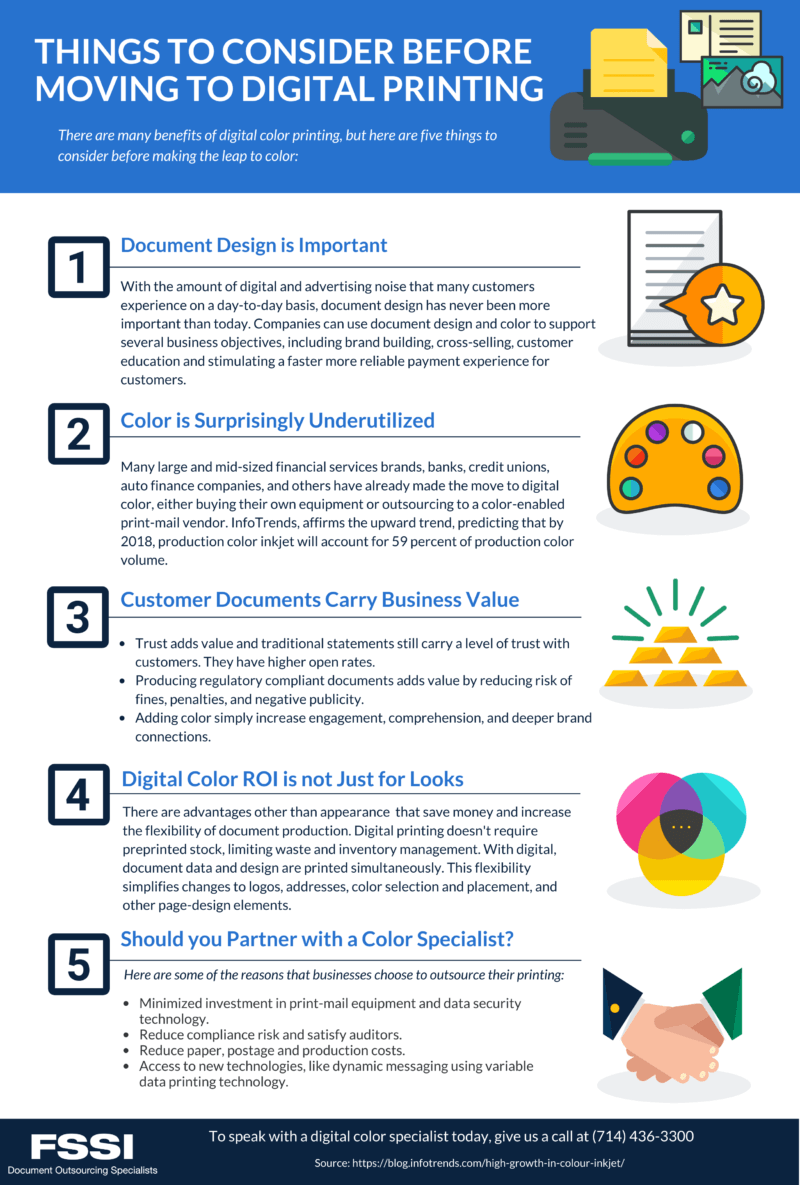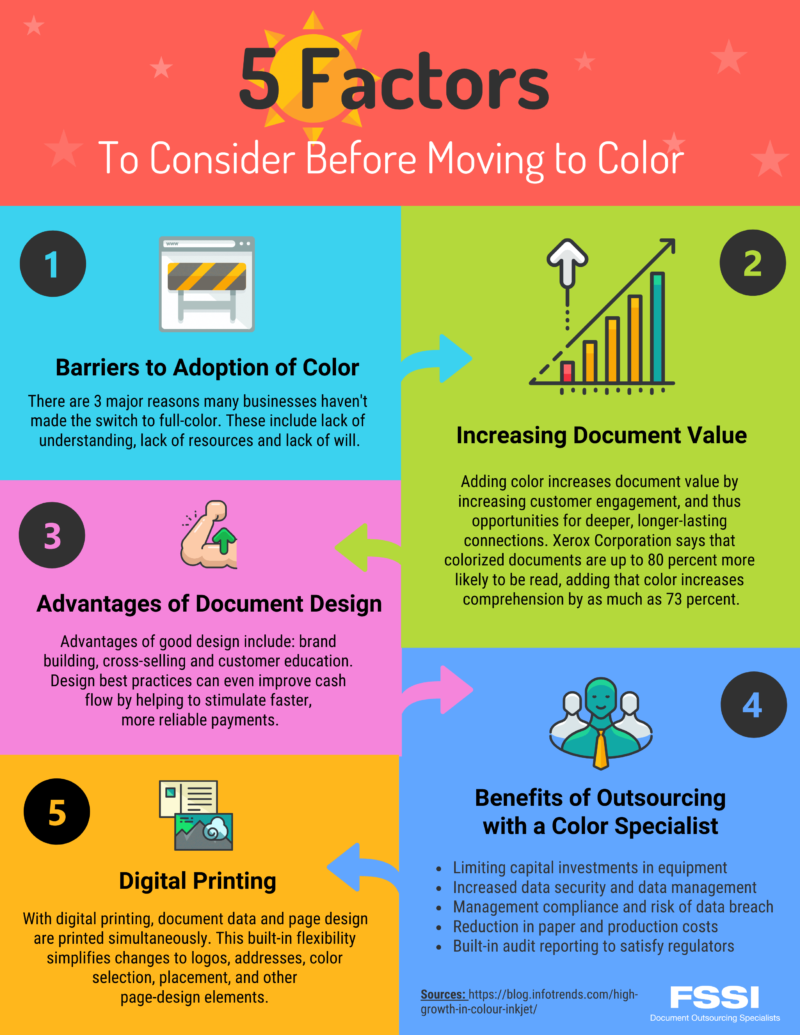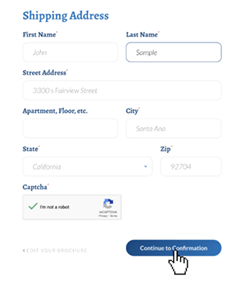Color Psychology, Document Design, How-to Guides, Outsourcing, Printing
The Benefits of Digital Printing: 5 Criteria to Consider

Can my Business Benefit from Digital Color Printing?
If recent trends are any indicator, high-volume statement mailers will soon consider moving from black-ink on white-paper customer documents to those that incorporate inkjet digital color. Studies suggest that the business advantages, including greater engagement, response rates, and loyalty, might be too good to ignore. There are many benefits of digital color printing, but there are five things to consider before moving to color.
But any organization contemplating the transition to inkjet printing will want to first understand the issues and options before either purchasing multi-million-dollar digital color printers or outsourcing production to a provider who’s already invested in one.
Whether you’ve just recently considered digital printing solutions, are actively gathering information, or are close to pulling the trigger, these five essential insights will show you the impact that color can have when used in your transactional customer documents and your overall business communications.

#1: Why is Document Design Important?
Document design plays a crucial role in meeting the expectations of today’s consumers who value personalized and high-quality communication across various channels. It serves as a powerful behind-the-scenes strategy, enabling companies to achieve multiple business objectives.
Effective document design supports brand building, facilitates cross-selling efforts, and enhances customer education. By implementing design best practices, businesses can even improve cash flow by encouraging faster and more reliable payments. Techniques such as simplified navigation, thoughtful layout, strategic use of colors to highlight messages, and emphasizing key information like account balances and payment details contribute to the importance of document design.
Thanks to marketers’ vigorous pursuit of personalization, today’s consumers expect high-production value from any form of communication they receive–from websites and direct mail to email and account statements. Marketers call this the expectation of ‘relevance.’
#2: Color use is increasing, but color printing is still underutilized in some industries
Many large and mid-sized financial services brands–banks, credit unions, auto finance companies, and others–have already made the move to digital inkjet color, either buying their own equipment or outsourcing to a color-enabled print-mail vendor. Technology research company, InfoTrends, affirms the upward trend, predicting that by 2018, production color inkjet will account for 59 percent of production color volume. This is nearly double the volume in North America and Western Europe compared to 2012.
Still, many organizations that could benefit from inkjet digital and adding color to statements have yet to make a move, mainly for reasons that include:
- Lack of understanding–Some companies view transactional documents as having little strategic value beyond their intended purpose. Document design best practices and their impact on customer behavior is often not considered.
- Lack of resources–Some internal factions see the cost of adopting digital color as prohibitive. While their concerns may be valid, they are also based on aging information. It would benefit a company to take a fresh look into the ROI of investing or outsourcing color printing. It may be more affordable than it was in the past.
- Lack of will–even when businesses decide to adopt inkjet digital color, there is often no internal ‘champion’ willing to (or has enough time to) lead or openly advocate the changeover.
These and many other challenges can leave color adoption in limbo.
#3: Increasing document value is not just a buzzword
Despite lots of conflicting opinions, customer-facing documents DO, carry a great deal of business value. They can be a valuable marketing tool to acquire and retain customers. Here are a few reasons why traditional customer documents are still valuable today:
Trust adds value
Unlike a lot of mail, transactional statements are still very valuable because consumers trust in them. By some estimates, people open and read up to 95 percent of these documents, which can include statements, invoices, and other account-related correspondence. They may also spend up to three times longer reviewing these documents.
Simple compliance management adds value
The Consumer Finance Protection Bureau (CFPB) is a watchdog agency established by Congress after the last banking meltdown. A specific subset of CFPB rules applies to the secure handling and processing of consumers’ personal and account information, like that found in financial documents.
Regulatory-compliant documents add value by reducing the risk of fines, penalties, and negative publicity. Noncompliant documents, or those produced in an under-certified or less-than-compliant setting, can quickly become a serious liability.
Adding color to statements adds value
Adding color increases document value by increasing customer engagement, and thus opportunities for deeper, longer-lasting connections. Xerox Corporation says that colorized documents are up to 80 percent more likely to be read, adding that color increases comprehension by as much as 73 percent.
#4 What are some of Inkjet’s biggest advantages and ROI gains?
Inkjet printing offers numerous advantages that go beyond its appealing visual characteristics, such as engagement, trust, and retention. Companies are increasingly investing in color document production due to the significant returns driven by various aspects of this technology.
One major advantage is the cost savings it provides. Inkjet printing eliminates the need for preprinted stock, reducing stock costs, management expenses, and warehousing fees. Additionally, the flexibility of inkjet printing allows for easy changes to logos, addresses, color selection, and page-design elements. This technology streamlines the design and finishing process, enabling dynamic adjustments like vertical or horizontal perforations without requiring pre- or post-production processing.
There’s no question that digital color’s appearance-driven benefits (engagement, trust, retention, etc.) are significant. But they are by no means the only upside. If they were few companies would be investing as they are today in color document production. Over time, however, the biggest returns may actually come from cost savings driven by other aspects of the technology.
#5: Outsourcing is a popular, beneficial and cost-effective digital printing solution
Companies today view color document production as a viable choice for improving their customer communications. As a result, we’ve seen continuous growth and client color conversions at FSSI.
Since purchasing our high-volume inkjet printing system, FSSI has helped clients in a wide range of verticals successfully transition to producing documents on an inkjet printer. From 2013 to the present, we have printed multiple millions of color documents. These documents include statements, bills, invoices, letters, and other customer-facing or compliance-related documents.
Outsourcing color document production, instead of keeping it in-house, can help your company:
- Minimize investments in print-mail equipment, data security, data management
- Reduce the risk of a costly data breach
- Avoid long-term lease commitments
- Reduce paper, postage and overall production costs
- Improve and stabilize cash flow
- Easy audit-ready reporting to satisfy compliance auditors

Summary
Many companies have started to consider the move from black ink on preprinted shells to digital inkjet color. This is due to competitive pressures, changes in consumer expectations and advances in color printing technology. The potential return on investment, studies suggest, might be too good to ignore.
If you have questions about moving to inkjet technology, contact one of our inkjet printing specialists. We’ll get back to you promptly with answers or suggestions.




